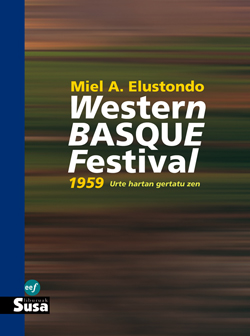
Aurkibidea
Aurkibidea
14
Donald Canterrek idatzitako bigarren erreportajea hurrengo egunean argitaratu zen. Lehenengoan bezala, hari mutur batetik abiatu zen, lanaren muinera heldu arte: Graves andrea. Flora Agirre. Eta, zinez, Donald Canterrek egunkarian idatzitako berria izan ez balitz, ez genukeen jakingo nor hasi zen, inor baino lehenago, bazterrak nahasten. Ez genukeen jakingo nori bururatu zitzaion, lehen-lehenik, jaialdiaren asmoa.
Mrs. Graves' father, Francisco, born in the Spanish province of Guipozcoa, sailed for America in 1905, herded a thousand sheep into the Idaho mountains within days of his arrival.
Came shearing time and Francisco marched his sheep back into town, bragged with other Basques about the looks of his herd, then headed for a boarding house for Basque girls, who didn't need much encouragement to dance «La Jota» with the lonely men from their home country.
That's how Francisco met pretty Gabina, who said she'd marry him, provided he'd spend more time with his wife than with sheep.
So Francisco told his Gabina of one aspect of a sheepherder's life that might solve their problem: The terrific wear on shoes wich makes a herder the shoemaker's best customer.
They agreed that Francisco should become a shoemaker, and thus be the first Basque in Idaho to serve the sheep by staying home.
Their daugther Flora left Idaho to marry casino boss Dick Graves, but that took her to Nevada's sheep country.
There, together with Nevada State Sen. Pete Echeverria and author Bob Laxalt, both sheepherders' sons, she first toyed with the idea of staging a Basque festival, now set for June 6-7.
She izan zen, beraz. Hortxe gaueko lana egunez ageri. Flora Agirre. Graves, Amerikan.